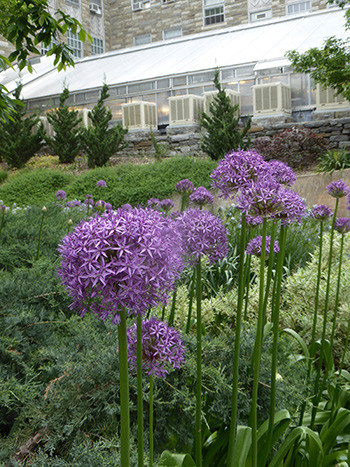
Plants of the Week: May 15
 Looking to add a bit of drama to the late spring garden? Consider planting Allium. Ornamental onions are easy to grow, and visually captivating. Related to culinary onions, alliums are critter-proof bulbs that are generally planted in the fall. While plants produce nondescript foliage, their flowers are architectural dynamos in the landscape. Flowers are held on sturdy stems and comprised of multiple florets.Depending on species and cultivar, most alliums bloom after tulips, filling the gap between spring bulbs and summer-blooming annuals.
Looking to add a bit of drama to the late spring garden? Consider planting Allium. Ornamental onions are easy to grow, and visually captivating. Related to culinary onions, alliums are critter-proof bulbs that are generally planted in the fall. While plants produce nondescript foliage, their flowers are architectural dynamos in the landscape. Flowers are held on sturdy stems and comprised of multiple florets.Depending on species and cultivar, most alliums bloom after tulips, filling the gap between spring bulbs and summer-blooming annuals.
Allium ‘Globemaster’ produces large purple flowers averaging 8-10 inches in diameter. While the bulbs are large, the foliage takes up minimal space and can be easily incorporated into any garden planting. Photo credit: J. Coceano
Allium ‘Mount Everest’ is another large flowering variety bearing white flowers. These hardy and floriferous bulbs can be found throughout campus. Alliums are featured in the Dean Bond Rose Garden, outside the Lang Center for Performing Arts, and nestled within plantings of the Terry Shane Teaching Garden. Photo credit: J. Coceano
Native fringe tree, Chionanthus virginicus, is looking stellar in the mid-May landscape. White panicles of flowers creating a fleecy, fluffy effect are borne in multitudes on the terminal ends of last year’s growth. Plants are dioecious (separate male and female plants), but may have perfect flowers on each plant.
Male flowers are showier than female flowers. Fertilized perfect or female flowers give way to clusters of olive-like fruits which ripen to a dark, bluish-black in late summer and are an excellent food source for birds and wildlife. A planting in front of Pearson Hall is particularly interesting.
Native Chionanthus virginicus is planted beside its Asian cousin, Chionanthus retusus, allowing for compare and contrast of the two relatives. Photo credit: J. Coceano






No Comments